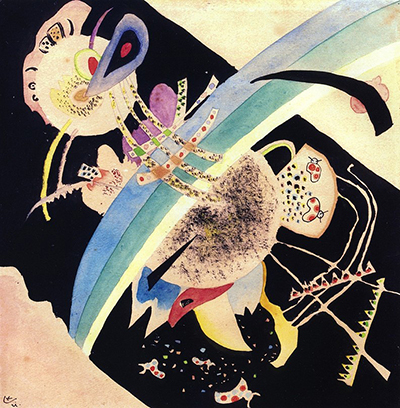Study for Circles on Black allows us to see into the developmental processes of Wassily Kandinsky, as he prepares for a later piece with a fairly detailed preparation painting.
One can immediately spot that whilst the layout is fairly well constructed, much of the detail in each shape is relatively limited, where as his finished paintings would give much more care and attention to each and every element. This was clearly an attempt by the artist to layout his preferred design but without spending too much time on it that could be better spent tweaking the final artwork. As such this study lacks much of the impact of his more famous paintings, but that does not matter as this was probably never intended to be seen by the public and was simply not meant to be considered as a completed artwork. Many of the smaller items that surround the larger shapes are also devoid of any great detail and are almost placeholders from which to experiment in the later versions.
By now, this was an artist who perfectly understood himself and so did not need to go into too much detail here. He knew how he would later expand upon these ideas and merely wanted to flesh out a layout, the like of which would then roughly appear in the finished piece. Any major layout changes would be much harder to carry out rather than simple adjustments on individual detail and so he wanted to be sure about the former prior to starting the larger, more detailed piece. He may well have started off initially by drawing the ideas out in pencil in an even earlier layer of study, before then moving to this point as colour started to also play a role. He was a skilled draughtsman but that medium failed to display his exceptional understanding of colour, as found in his more famous paintings such as Composition VI, Composition VII, Composition VIII, for example.
The success of this artist, and the huge value that surrounds his major works, has led to an increased interest in some of the lesser known pieces from his career. They also now have an intrinsic value and are popular with collectors, most of whom would be unable to realistically bid on his more famous pieces. Study pieces have therefore become a part of that, and the more complete that they are, then the more valuable they would be. This piece in front of us here is certainly full of enough detail and colour to provide a helpful insight into his working practises and would surely be considered particularly valuable today, even though it was a method of preparing for something else. It is still from the hand of Kandinsky, after all.




